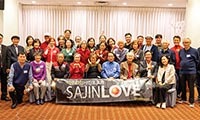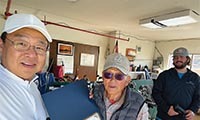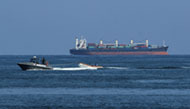So there may be few better bases of operation for an unusual academic program that has taken root here , in which scholars study and make art in places about as far away from museums and galleries as is possible within the continental United States.
Called Land Arts of the American West, the classes take place in a pair of heavy-duty Ford vans or wherever the vans and the camping gear they carry end up stopping during a 11,000-kilometer , two-month drive throughout the West.
The tangible result of the trip is an annual exhibition of art, writing and other documentary material about the journey (landarts.org for more information).
But the heart of the program exists out on the road. Chris Taylor, a Harvard- trained architecture professor who helped develop the concept, along with an artist named Bill Gilbert, directs the program at Texas Tech University here in Lubbock, which puts him and his students at the eastern edge of the huge swath of territory - southwestern Texas, New Mexico, Arizona, Utah and Nevada - that he has made his classroom.
Many of the stops on the trip are expected, the legacies of the land-art and Earthworks movement, which transplanted the idea of sculpture to the country’s trackless open spaces beginning in the 1960s: Robert Smithson’s “Spiral Jetty,” off the shore of the Great Salt Lake ; Walter De Maria’s “Lightning Field,” in western New Mexico; Nancy Holt’s “Sun Tunnels,” in northwestern Utah; Michael Heizer’s “Double Negative,” two deep trenches cut into the edge of a mesa in the Nevada desert.
But other stops, some requiring close observation of the odometer in places so remote that GPS maps are of little use, suggest an itinerary drawn up by Rachel Carson and Howard Zinn, with help from Foucault and the Marquis de Sade. Students have spent time near one of the world’s largest open-pit uranium mines, now inactive, on the Laguna Pueblo reservation west of Albuquerque. They have camped on a desolate patch of New Mexico desert land called Cabinetlandia, owned by the art magazine Cabinet, wedged between an active rail line and screaming traffic on Interstate 10, where there is little more in the way of amenities than a mailbox and a filingcabinet community “library” embedded in a concrete-and-soil wall.
The program operates on a small budget of about $30,000, provided by participants’ fees and donations. Mr. Taylor said he planned it to try to be as agnostic about the definition of art as the vast landscape itself is. “I define art as anything people have done on the land,” he said, adding that the West is an ideal place for such an approach. (“Arid lands are unable to hold secrets,” Mr. Taylor once wrote.)
He added: “ Not to take anything away from art history, but this is more broadly about how we’ve shaped the land, and how it has shaped us.”
William L. Fox, a writer and the director of the Center for Art + Environment in Reno, said he believed that these kinds of wildly interdisciplinary art-making and academic activities might be flourishing in the West because artists see it as a place where boundaries are less rigid.
“For me, art is about making metaphors, and to do that you feed on new sources of information,” said Mr. Fox . “In a sense that’s all artists are doing, the same as scientists: ‘What areas can we poke our noses into that give us new information and show us how to make work in a way we’ve never thought of?’”
Rocio Mendoza, an architecture graduate student who traveled with the group in 2010, returned to Lubbock to propose a kind of design idea that at first glance might seem like merely a fantastical conceptual exercise: to erect tens of thousands of small, cheap shelters along the United States’ border with Mexico. But the idea came to her after she walked away from the group one morning in the southern Arizona scrub and ran into two disoriented Mexican men who were crossing illegally into the country and asked her for food.
She made a video about the experience, in which she recalled her mother’s stories of being carried across the Rio Grande many years before, seven months pregnant with Ms. Mendoza. “Meeting those two guys,” she says in the video, looking into the camera, “it all suddenly clicked and became personal and political.”
By RANDY KENNEDY
스마터리빙
more [ 건강]
[ 건강]이제 혈관 건강도 챙기자!
[현대해운]우리 눈에 보이지 않기 때문에 혈관 건강을 챙기는 것은 결코 쉽지 않은데요. 여러분은 혈관 건강을 유지하기 위해 어떤 노력을 하시나요?
 [ 건강]
[ 건강]내 몸이 건강해지는 과일궁합
 [ 라이프]
[ 라이프]벌레야 물럿거라! 천연 해충제 만들기
 [ 건강]
[ 건강]혈압 낮추는데 좋은 식품
[현대해운]혈관 건강은 주로 노화가 진행되면서 지켜야 할 문제라고 인식되어 왔습니다. 최근 생활 패턴과 식생활의 변화로 혈관의 노화 진행이 빨라지고
사람·사람들
more
“취미생활로 다진 친목… 선후배들과 만든 모교사랑”
사진러브한인 사진 동호회 사진러브(회장 크리스 고)는 13일 용수산에서 송년모임을 갖고 한 해를 마무리하는 뜻깊은 시간을 가졌다. 이날 모임에…

[홀인원] 이상원 박사
일반외과 전문의 이상원(왼쪽) 박사가 지난 9일 뉴포트비치 소재 골프장 9번 홀(152야드)에서 레스큐 클럽으로 친 샷이 그대로 홀에 빨려 들…
[송년행사 게시판] 재미시인협회
재미시인협회(회장 지성심)는 오는 20일 오후 4시 가든스윗호텔에서 한 해를 마무리하며 동인지 ‘외지’ 제35집 출판 기념회와 ‘제23회 재미…
[송년행사 게시판] 향군단체 연합
6.25 참전유공자회와 대한민국 육군협회 등 남가주 지역 향군 단체 연합은 19일 오전 11시30분, 용궁에서 송년 행사를 개최한다. 드레스코…
[송년행사 화보] “이웃과 함께 나누고 지인과 함…
KYCC13일 윌튼 플레이스 초등학교에서 열린 ‘한인타운청소년회관(KYCC) 홀리데이 카니발’이 성황리에 막을 내렸다. 올해는 KYCC 창립 …
많이 본 기사
- 한국계 NASA 우주비행사 조니 김 “우주서 김치·밥 그리웠다”
- 엡스타인 파일 공개 다음날 트럼프 사진 삭제…야당서 탄핵 경고
- 김주하, 이혼사 최초 고백 “ ‘불륜’ 전 남편에 맞아 고막 파열..목 졸린 적도”
- 맘다니 승리 이끈 ‘감당 가능 생활비’, 내년 선거 화두 급부상
- 백악관 “인플레, 목표치보다 낮아…금리 인하 여지 충분”
- ‘매관매직’ 尹부부 금주 동반 재판행…특검, 최종 법리 검토
- 30년 만에 의문의 비극…과 동기에 피살 ‘승승장구’ MIT 교수
- BTS 정국과 열애설 후 첫 SNS..에스파 윈터, 커플 타투는 가렸다
- ‘최초+최초+최고’ 안세영, ‘허벅지 내리치는 투혼’→왕중왕전도 석권... ‘11회 우승’ 역대 최초 상금 100만 달러 돌파
- “노는 것도 지겨워” 박미선, 유방암 투병 중 ‘SNS 공구’ 갑론을박
- 판례 잘못 인용해 머스크 손들어준 판사… “AI 쓰다 오류” 의혹
- ‘韓 EPL 센터백 탄생하나’ 국가대표 이한범, 에버턴 관심 현지 보도
- 백악관 “인플레, 목표치보다 낮아…금리 더 일찍 내렸어야”
- 엡스타인 파일 공개 다음날 트럼프 사진 삭제…야당서 탄핵 경고
- 마두로 정권 더 옥죄는 美…베네수 연안서 유조선 추가 나포
- ‘손예진♥’ 현빈, 학부모 모드ON.. “아들이 배우 한다면? 하..” 한숨
- ‘反트럼프’ 공화 큰손, 작년 대선에만 약 5억4천800만달러 썼다
- 아마존, 키보드입력 데이터 분석해 위장취업 北노동자 적발
- 청와대 내년부터 본격화…여민관 ‘정책허브’로
- ‘열애설→결별설 겪은’ 제니·지드래곤, 단둘이 ‘MMA’ 대상 쓸어갔다
- 신민아♥김우빈, 결혼식날 전한 깜짝 … 1
- 머스크 재산… 사상 초유 7천억달러 돌파
- ‘SNS검증’ 美비자심사 지연에…빅테크, 또 직원 출국자제 권고
- ‘공천개입’ 이준석 첫 특검 출석… “尹과 공범엮기 무리한 시도”
- 엡스타인파일 공개 후폭풍…법무부 ‘트… 2
- 美, 우크라戰 종전 중재 속도…마이애미서 우크라·러 연쇄회동
- 트럼프, ‘바이든 임명’ 직업 외교관 출신 대사들 대거 소환
- 美·이집트 등 4개국, 가자 평화구상 진전·후속조치 논의
- 교황, 전세계 추기경 바티칸 소집…내달 7∼8일 첫 회의
- [건강포커스] “밤에 더 자주 깨는 어르신, 다음 날 인지수행 능력 떨어져”
- 尹 김건희특검 첫 조사 8시간 반 만에 종료…6개 혐의 모두 부인
- ‘미소천사’ 김아랑, 너무도 진솔했던 ‘은퇴 이유’ 고백 “경기 후 아쉬움 아닌 고마움 들어 결심했다”
- 위성락 “내년부터 농축·재처리·핵잠 한미협의 동시다발 진행”
- ‘이젠 SD 송성문’ 3루엔 ‘3억 5000만 달러’ 마차도 버티는데... 단장이 답했다 “다양한 역할 소화할 것”
- “산타 지금 어디쯤?”…한국서도 70년 전통 전화 안내 즐긴다
- ‘새댁’ 함은정, 결혼식 하자마자..내조의 여왕
- ‘중독유발 비판’ 챗GPT, 아동보호 기능 이어 ‘친절함 정도’ 도입
- ‘부상 아웃 공식 확정’ 이강인, 절뚝일 때부터 이상했다 “왼쪽 허벅지 근육 이상”... 폼 최고였는데 아쉬워
- 요르단 “美 시리아 IS 공습에 참여…안보 위협 저지”
- 젤렌스키 “우크라 선거 방식, 푸틴이… 3
- 안세영, ‘천적’ 야마구치도 넘었다…역대 최다승까지 단 한 걸음
- 與 “내란 2차 종합 특검해야”…국힘 “통일교 특검이 국민 명령”
- 쿠팡 주주, 美법원에 집단소송… “정… 1
- “네타냐후, 트럼프 만나 ‘이란 추가 타격’ 설명 계획”
1/5지식톡

-
 ☝️해외에서도 가능한 한국어 선생님…
0
☝️해외에서도 가능한 한국어 선생님…
0이 영상 하나면 충분합니다!♥️상담신청문의♥️☝️ 문의 폭주로 '선착순 상담'만 진행합니다.☎️ : 02-6213-9094✨카카오톡ID : @GOODEDU77 (@골뱅이 꼭 붙여주셔야합니다…
-
 테슬라 자동차 시트커버 장착
0
테슬라 자동차 시트커버 장착
0테슬라 시트커버, 사놓고 아직 못 씌우셨죠?장착이 생각보다 쉽지 않습니다.20년 경력 전문가에게 맡기세요 — 깔끔하고 딱 맞게 장착해드립니다!장착비용:앞좌석: $40뒷좌석: $60앞·뒷좌석 …
-
 식당용 부탄가스
0
식당용 부탄가스
0식당용 부탄가스 홀세일 합니다 로스앤젤레스 다운타운 픽업 가능 안녕 하세요?강아지 & 고양이 모든 애완동물 / 반려동물 식품 & 모든 애완동물/반려동물 관련 제품들 전문적으로 홀세일/취급하는 회사 입니다 100% …
-
 ACSL 국제 컴퓨터 과학 대회, …
0
ACSL 국제 컴퓨터 과학 대회, …
0웹사이트 : www.eduspot.co.kr 카카오톡 상담하기 : https://pf.kakao.com/_BEQWxb블로그 : https://blog.naver.com/eduspotmain안녕하세요, 에듀스팟입니다…
-
 바디프렌드 안마의자 창고 리퍼브 세…
0
바디프렌드 안마의자 창고 리퍼브 세…
0거의 새제품급 리퍼브 안마의자 대방출 한다고 합니다!8월 23일(토)…24일(일) 단 이틀!특가 판매가Famille: $500 ~ $1,000Falcon: $1,500 ~ $2,500픽업 & 배송직접 픽업 가능LA…
케이타운 1번가
오늘의 1면
오피니언
 한영일 / 서울경제 논설위원
한영일 / 서울경제 논설위원[만화경] 웰다잉 인센티브
 캐슬린 파커 워싱턴포스트 칼럼니스트
캐슬린 파커 워싱턴포스트 칼럼니스트 [캐슬린 파커 칼럼] 아이들을 온라인에서 보호하기
 양상훈 수필가ㆍ시인
양상훈 수필가ㆍ시인 [한국춘추] 경제대공황ㆍ제2차 세계대전 승리로 극복한 루스벨트 리더쉽

[왈가 왈부] 고환율에 외환 건전성 완화·서학개미 규제… 미봉책 아닌가요
 수잔 최 한미가정상담소 이사장 가정법 전문 변호사
수잔 최 한미가정상담소 이사장 가정법 전문 변호사 [수잔 최 변호사의 LIFE &] AI 시대 편리함에 안주하지 말자
 김도년 성균관대 건축학과 교수 스마트도시·건축학회장
김도년 성균관대 건축학과 교수 스마트도시·건축학회장 [로터리] 지멘스가 만드는 미래 동네
1/3지사별 뉴스

퀸즈장로교회 ‘사랑의 바구니’130개 이웃에 전달
퀸즈장로교회가 18일 크리스마스를 앞두고 교인들의 정성과 사랑이 듬뿍 담긴 ‘사랑의 바구니’ 130개를 소방서와 경찰서, 요양원, 선교회, 그…
시민권 박탈 착수⋯매달 200명

“이웃 돌보는 여러분이 동역자”
워싱턴성광교회(담임목사 임용우)는 18일 한인단체와 소방서‧도서관 등에 총 2만9천 달러의 성금을 전달했다. 지난 2011년부터 15년째 지역…
소기업 지원에 1천만 달러 투자

백악관 “인플레, 목표치보다 낮아…금리 더 일찍 내렸어야”
케빈 해싯 백악관 국가경제위원회(NEC) 위원장은 21일 중앙은행인 연방준비제도(Fed·연준)가 “금리를 더 일찍 내렸어야 했다”고 말했다.해…
엡스타인 파일 공개 다음날 트럼프 사진 삭제…야당서 탄핵 경고

오늘 하루 이 창 열지 않음 닫기 




















































.png)


댓글 안에 당신의 성숙함도 담아 주세요.
'오늘의 한마디'는 기사에 대하여 자신의 생각을 말하고 남의 생각을 들으며 서로 다양한 의견을 나누는 공간입니다. 그러나 간혹 불건전한 내용을 올리시는 분들이 계셔서 건전한 인터넷문화 정착을 위해 아래와 같은 운영원칙을 적용합니다.
자체 모니터링을 통해 아래에 해당하는 내용이 포함된 댓글이 발견되면 예고없이 삭제 조치를 하겠습니다.
불건전한 댓글을 올리거나, 이름에 비속어 및 상대방의 불쾌감을 주는 단어를 사용, 유명인 또는 특정 일반인을 사칭하는 경우 이용에 대한 차단 제재를 받을 수 있습니다. 차단될 경우, 일주일간 댓글을 달수 없게 됩니다.
명예훼손, 개인정보 유출, 욕설 등 법률에 위반되는 댓글은 관계 법령에 의거 민형사상 처벌을 받을 수 있으니 이용에 주의를 부탁드립니다.
Close
x